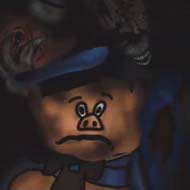
The Three Little Pigs (Analog Horror) transforms a childhood story into a chilling survival game set in a distorted, VHS-styled world. You control different pig characters trying to defend themselves from a grotesque, ever-watching wolf that stalks the map with growing intelligence. This is not a fairy tale—it’s a tense, paranoia-fueled escape through crumbling environments, flickering visuals, and haunting clues.
This game plays out across multiple nights, each more unstable than the last. The pig characters rotate depending on the level, each with their own traits and vulnerabilities. The wolf operates using a learning AI that adapts to your movements, hiding spots, and timing. Lights dim, sounds distort, and security cameras fail, leaving you to rely on memory, notes, and sound cues to escape each encounter.
The Three Little Pigs (Analog Horror) uses degraded visual filters and audio glitches to build tension. Static interference masks real danger, making it difficult to predict movement or decipher clues. You’ll often need to rewatch camera footage in reverse, decode scrambled text, and manipulate retro tech to survive.
Rather than direct exposition, the game relies on environmental storytelling. Graffiti, damaged walls, and broken dolls reveal the pigs’ disturbing backstories. Old fairytale books contain redacted pages, and some levels loop until certain hidden conditions are met. It becomes clear that this isn’t just a predator-prey scenario, but a reenactment of something much older and much more controlled.
The Three Little Pigs (Analog Horror) delivers more than scares. It uses atmospheric design, broken fairy tale logic, and unpredictable mechanics to build a game where every choice matters and every shadow might be something watching you back.